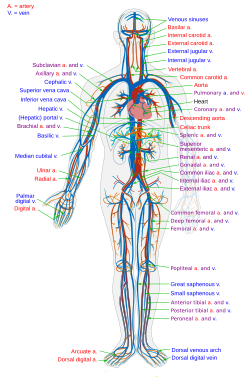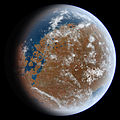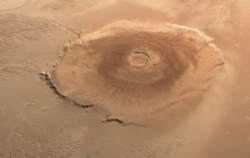Mars General Circulation Model The Mars general circulation model is the result of a research project by NASA to understand the nature of the general...
16 KB (1,768 words) - 04:42, 2 June 2025
observed in winter. Predictions from the Mars General Circulation Model are consistent with these observations. Mars has ice caps at its north pole and south...
114 KB (11,742 words) - 00:32, 16 June 2025
Hadley cell (redirect from Hadley circulation)
the winter hemisphere. Analogous circulations may occur in extraterrestrial atmospheres, such as on Venus and Mars. Global climate is greatly influenced...
99 KB (11,804 words) - 02:28, 25 July 2025
have been active on ancient Mars, though this remains contentious. Objections chiefly arise from repeated results from models of martian paleoclimate suggesting...
20 KB (2,735 words) - 11:01, 25 May 2025
Circulatory system (redirect from Blood circulation)
circulatory system has two divisions, a systemic circulation or circuit, and a pulmonary circulation or circuit. Some sources use the terms cardiovascular...
52 KB (5,819 words) - 22:03, 3 August 2025
Mars is the fourth planet from the Sun. It is also known as the "Red Planet", because of its orange-red appearance. Mars is a desert-like rocky planet...
209 KB (18,471 words) - 23:06, 23 July 2025
detection of O 2 1.27 μ m nightglow emission at Mars with OMEGA/MEX and comparison with general circulation model predictions". Journal of Geophysical Research:...
78 KB (8,137 words) - 07:49, 24 June 2025
principle cannot be driven by inviscid axisymmetric circulations. Assimilated data and general circulation model (GCM) simulation suggest that super-rotating...
149 KB (15,307 words) - 14:32, 25 July 2025
Sol (borrowed from the Latin word for sun) is a solar day on Mars; that is, a Mars-day. A sol is the apparent interval between two successive returns...
9 KB (884 words) - 13:49, 5 June 2025
average gravitational acceleration on Mars is 3.728 m/s2 (about 38% of the gravity of Earth) and it varies. In general, topography-controlled isostasy drives...
53 KB (6,282 words) - 00:06, 9 April 2025
precise topographic maps of Mars. The precision maps are applicable to studies in geophysics, geology and atmospheric circulation. MOLA also functioned as...
5 KB (484 words) - 12:05, 25 May 2025
Martian dichotomy (redirect from Northern hemisphere of Mars)
gravity and topography of Mars to constrain the location of the dichotomy beneath the Tharsis rise, thus creating an elliptical model of the dichotomy boundary...
21 KB (2,741 words) - 04:53, 14 June 2025
1996 book The Case for Mars. It now serves as a staple of Zubrin's speaking engagements and general advocacy as head of the Mars Society, an organization...
23 KB (3,039 words) - 19:17, 5 June 2025
measurements from the MOLA instrument, Mars Climate Sounder (MCS), and the Martian General Circulation Model (MGCM), point to cloud formations on the...
8 KB (867 words) - 22:42, 23 May 2025
Mars may contain ores that would be very useful to potential colonists. The abundance of volcanic features together with widespread cratering are strong...
27 KB (3,423 words) - 10:50, 27 March 2025
Hellenistic astronomers developed a geocentric model to explain the planet's motions. Measurements of Mars' angular diameter can be found in ancient Greek...
74 KB (7,726 words) - 20:24, 22 April 2025
The pulmonary circulation is a division of the circulatory system in all vertebrates. The circuit begins with deoxygenated blood returned from the body...
32 KB (4,099 words) - 19:28, 2 July 2025
northern mid-latitude glaciation with a general circulation model. In: Seventh International Conference on Mars. Abstract 3096. Head, J. and D. Marchant...
51 KB (6,236 words) - 15:46, 1 August 2025
perturbations on Mars by asteroids have caused problems, they have also been used to estimate the masses of certain asteroids. But improving the model of the asteroid...
14 KB (1,726 words) - 08:30, 27 May 2025
The colonization of Mars is the proposed process of establishing permanent human settlements on the planet Mars. Most colonization concepts focus on settling...
127 KB (12,758 words) - 23:01, 13 July 2025
The Mars ocean theory states that nearly a third of the surface of Mars was covered by an ocean of liquid water early in the planet's geologic history...
45 KB (5,197 words) - 07:21, 7 July 2025
humans to Mars has been the subject of aerospace engineering and scientific studies since the late 1940s as part of the broader exploration of Mars. Long-term...
56 KB (5,806 words) - 23:42, 14 July 2025
Rain and snow were regular occurrences on Mars in the past; especially in the Noachian and early Hesperian epochs. Water was theorized to seep into the...
34 KB (3,959 words) - 13:11, 14 May 2025
Olympus Mons (category Mountains on Mars)
Olympus') is a large shield volcano on Mars. It is over 21.9 km (13.6 mi; 72,000 ft) high as measured by the Mars Orbiter Laser Altimeter (MOLA), about...
31 KB (3,668 words) - 13:32, 4 August 2025
The possibility of life on Mars is a subject of interest in astrobiology due to the planet's proximity and similarities to Earth. To date, no conclusive...
213 KB (20,792 words) - 13:27, 31 July 2025
The MARS-500 mission was a psychosocial isolation experiment conducted between 2007 and 2011 by Russia, the European Space Agency, and China, in preparation...
26 KB (2,968 words) - 06:13, 28 May 2024
Deimos (moon) (redirect from Mars II)
Deimos (/ˈdaɪməs/; systematic designation: Mars II) is the smaller and outer of the two natural satellites of Mars, the other being Phobos. Deimos has a mean...
30 KB (2,842 words) - 03:00, 8 June 2025
methane on Mars refers to reports of detection of methane (CH4) in Mars’ atmosphere. The potential presence of methane in the atmosphere of Mars may indicate...
26 KB (2,646 words) - 01:33, 29 May 2025
very small amounts of liquid water may occur transiently on the surface of Mars, limited to traces of dissolved moisture from the atmosphere and thin films...
294 KB (30,929 words) - 07:08, 7 August 2025
Phobos (moon) (redirect from Mars I)
Phobos (/ˈfoʊbəs/; systematic designation: Mars I) is the innermost and larger of the two natural satellites of Mars, the other being Deimos. The two moons...
73 KB (7,478 words) - 22:51, 27 July 2025



























